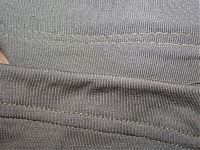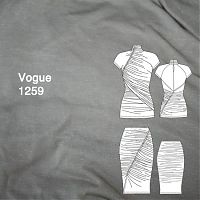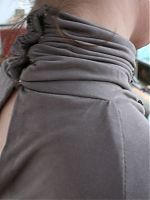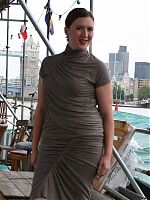I’ve finally finished Vogue 1259! I don’t regularly sew Vogue patterns (or any envelope patterns, for that matter), but like plenty of other people, I just loved this design as soon as it appeared online, and I just couldn’t wait to sew it up!
I used this mushroom-coloured viscose/cotton/lycra jersey from Tia Knight on ebay, and it was perfect for this pattern. You really need something lightweight and drapey, because there are a LOT of gathers that would get bulky very quickly in anything heavier. Vogue don’t give combined yardages for making the top and skirt, but 3m was just enough for me to make both, in size 16, using their recommended layout.
This pattern is marked as “Advanced”, and I think the top definitely qualifies, both for construction, as well as the cutting and marking, and the following of their instructions (which certainly don’t make things easier!). The skirt, however, could easily be made by a beginner. So if you’re intimidated by the “Advanced” label but like the skirt, go for it!
Not apparent in Vogue’s tech drawing:
- There are no side seams (on the top or skirt)
- There are no shoulder seams
- The collar is integrated, not separate pieces
- There are three inset corners in this pattern
- The diagonal line on the lower front is an overlap, not a seam
- Piece 1 wraps almost entirely around the body, but is mostly hidden under other layers (mainly Piece 5)
- There is no gathering on the top’s right side through the waist and hips (on the left in the photos and tech drawing above) – the fabric is just bunched into place through wear
- The skirt is only one pattern piece, with one diagonal seam.
- The ruffled seams have exposed edges
- Most seams are sewn twice, with straight stitches on the sewing machine (this is not serger/overlocker friendly!)
You can read more about my tips for cutting out the fabric here, but here’s a reminder of exactly how much space this takes up:

No pattern piece is cut twice, nor on the fold, and it’s all single-layer. I think only NancyK or a professional would have a cutting table big enough to contain this – for everyone else, get down on the floor…
Some overall tips:
- Use different coloured thread for the small circles, large circles, squares, and notches (and make yourself a key somewhere saying which colour is which symbol!). Chalk will rub off!
- Label your pattern pieces! I wrote the number and name on a mini post-it pinned to the right side of each piece and this saved my bacon more than once!
- Do all your gathering stitches in a contrast thread colour before you do any stitching. This really helps keep momentum up while you’re constructing, and makes it easier to identify the various edges of the pieces.
- Make sure you press the seam allowances open on the centre back seam (between pieces 2 and 3). I kept coming back to this seam again and again to orient myself, as it was the only easily identifiable seam in the pattern (and it’s noted on most of the drawings in the instructions, too).
- When you get to a really tricky part, it helps to start pinning the pieces together on a dressform or other person so you don’t end up getting a piece twisted around or in a wildly wrong place.
- Take. Your. Time. Step away from the machine when you feel your brain melting and you’re starting to get tired/frustrated/drunk/etc. This is a pattern that really requires your full concentration.
- Don’t remove your gathering stitches or trim your exposed seams until the very end. Just in case.
- Vogue’s hem method is just stupid. They have you fold the hem, baste along the fold, baste along the top of the hem allowance, then stitch along the top of the hem allowance, and then stitch 1/4” away from that. Then remove the basting stitches. W.T.F. Besides being overly time consuming, having parallel lines of straight stitches just looks bad, and doesn’t stretch with the jersey fabric. Ignore their crazy hem instructions and break out your twin needles or coverstitch instead.

Top: Vogue’s parallel straight-stitch hem. Beneath: My coverstitched hem
One thing I really hated during the construction is that Vogue used a million circles and notches which can easily get confused, especially when there are multiple small circles on one piece.. Manequim, KnipMode, and Burda, in contrast, number their seam intersections which makes it much easier to piece together a pattern without any instructions. In this case, Vogue’s illustrations were great, but their text instructions just blew. Most of this was down to the poor naming of the pattern pieces, so you end up with instructions like “Attach the right side of the front and back top to the left side of the upper left and back, etc etc…” I eventually just started underlining the piece names in their instructions and writing the piece number next to it instead, as my brain had a much easier time processing something like “Sew the top edge of 3 to the bottom edge of 4 and topstitch, etc etc”.
Step 21 has probably the most useful illustration in the entire instructions, as it at least shows you how some of the pieces fit together (Also note in red where I’ve underlined piece names and written the number alongside):

(the only thing you can’t see here is that Piece 1 is also underneath Piece 5)
I probably should have created the following diagram before I started sewing, or even made a paper version of the pattern first, but this is my attempt to show the top’s pattern pieces fit together in the hopes that it’ll help someone else at least!
I’ve indicated the gathered edges in green, where the hem, collar, and sleeve edges lie in purple, and I’ve numbered a few of the seam intersections in hot pink so you can see where things join up. In other words, the kind of diagram I wished Vogue had done! (Seriously, would it kill them to put the notches and circles on the mini pattern piece drawing like all the pattern magazines do?)
Sewing the skirt
After sewing the top, making the skirt was a walk in the park by comparison! It only took a few minutes to construct (especially because I’d already done all the gathering stitches when I did the top’s), but I think Vogue’s finishing methods leave a lot to be desired on this.
First of all, I finished the waistband using my favourite method for applying elastic rather than Vogue’s casing. I find that elastics always find a way of twisting around and bunching badly inside casings, so I prefer to serge, flip, and topstitch instead.
It’s a design choice that the only seam is the diagonal, gathered one in front, but this means that unless the skirt is sausage-casing tight or you’re wearing velcro underwear, the gathers don’t really stay up in the back. As a result, you get an ungathered back with only a thin layer of fabric (hello there, lumps and bumps!), and the hem falls in the back as it’s not being gathered. One solution could be to cut another length of stay tape the same length as indicated for the front and apply it on the diagonal somewhere on the back, gathering up the fabric to match. I’ve got plenty of twill tape leftover, so if I find this really bothers me, I’m going to try this modification myself.
Apologies for the utter essay I’ve written here, but I felt the need to really document this pattern as well as possible since (I think?) I’m the first on the internet to sew this up. I really like the end result, but I think Vogue could’ve made the process a lot easier with some better diagrams and instructions. I’ve attempted to fill in what I felt was missing, so if you found all this helpful, please let me know!
















